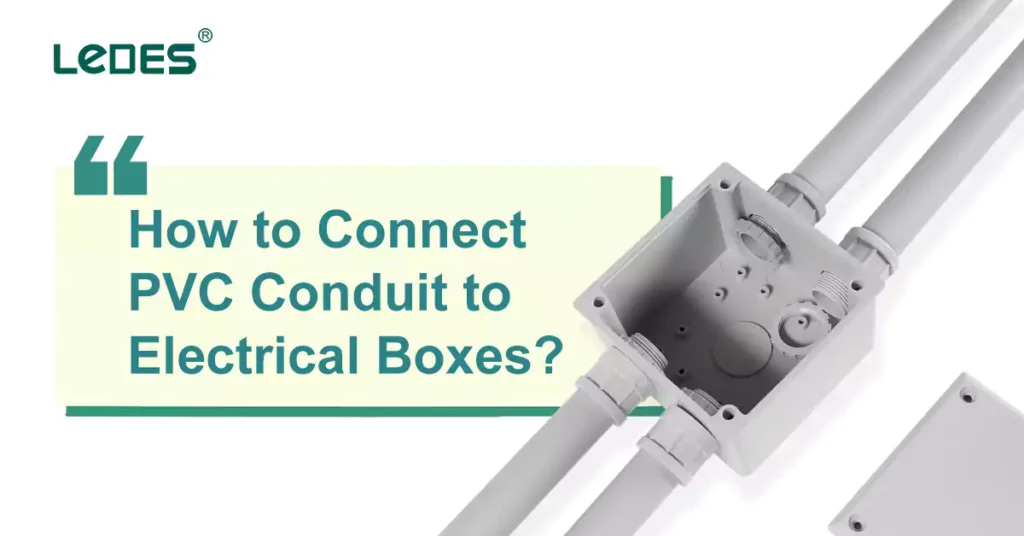
Inhaltsverzeichnis
Electrical installations require a meticulous approach to ensure proper wiring and safety. One crucial aspect of these installations is how to connecting PVC conduit to electrical boxes. PVC conduit serves as a protective housing for electrical wiring, safeguarding it from damage and providing a neat and organized appearance. In this guide, we will explore the significance of connecting PVC conduit to electrical boxes and provide you with a step-by-step process to accomplish this task effectively.
The Importance of PVC Conduit and Electrical Boxes’ Connection
Connecting PVC conduit to electrical boxes is a critical step in electrical installations for several reasons. Erstens, it provides a secure and enclosed pathway for electrical wiring, protecting it from physical damage, moisture, and other environmental factors. The conduit acts as a barrier, shielding the wires from potential hazards and reducing the risk of electrical shocks or short circuits.
Zweitens, connecting PVC conduit to electrical boxes ensures proper organization and management of electrical wiring. It allows for a structured and systematic approach, making troubleshooting, repairs, and upgrades easier in the future. By neatly routing the wires within the conduit and connecting them to the appropriate electrical boxes, you create a tidy and accessible electrical system.
Lastly, connecting PVC conduit to electrical boxes aligns with electrical codes and regulations. These codes are designed to promote safety standards and ensure that electrical installations are carried out in a compliant manner. Properly connecting conduit to electrical boxes is an essential part of meeting these requirements and maintaining a safe electrical environment.
In this guide, we will delve into the process of connecting PVC conduit to electrical boxes. We will explore various types of electrical boxes commonly used in installations, including junction boxes, switch boxes, and outlet boxes. Additionally, we will consider factors such as the type of conduit (rigid or flexible) and the materials used in the construction of the boxes (metallic or nonmetallic).
By following the step-by-step instructions provided, you will gain the necessary knowledge and skills to connect PVC conduit to electrical boxes confidently. Whether you are a DIY enthusiast or a professional electrician, understanding this process is vital for ensuring a secure and reliable electrical system.
6 Types of Electrical Boxes
There are many different types of electrical boxes, and the method of connecting PVC conduit to them. Here are some of the common used electrical box types.
Junction Boxes (Definition and Purpose)
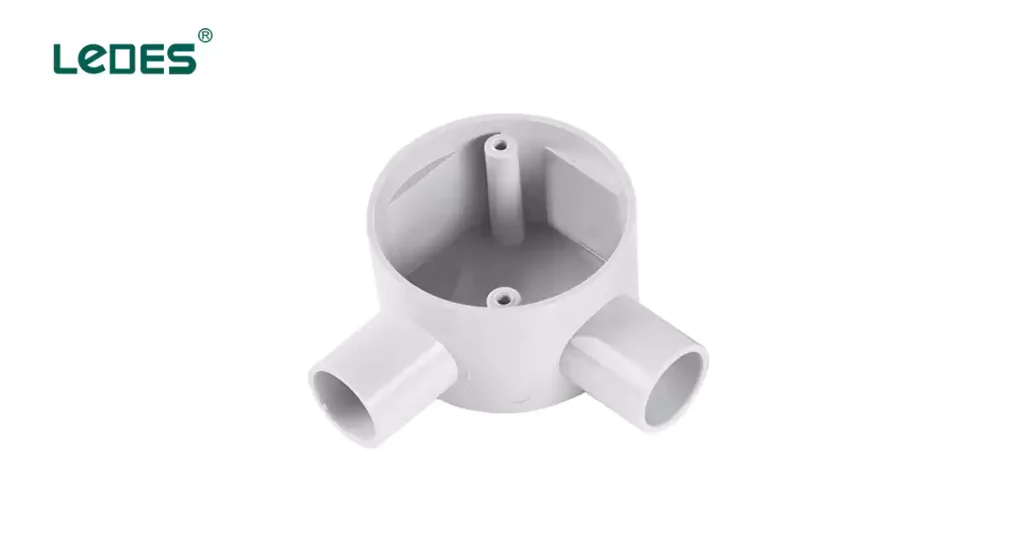
Anschlussdosen, also called terminal boxes or J-boxes, are protective enclosures that house and shield electrical wiring connections and wire splices from environmental factors and accidental contact. They are commonly installed in roofs, walls, and concrete plaster. It acts as a central hub where multiple wires can be securely joined together. Junction boxes are crucial for ensuring electrical safety, organizing wires, and complying with codes and regulations.
When connecting PVC conduit to junction boxes, 3 factors should be considered:
Conduit size and compatibility: Ensure that the size of the PVC conduit matches the knockout holes or openings on the junction box. Use connectors or fittings specifically designed for PVC conduit to establish a secure connection.
Erdung: Follow electrical codes and regulations to ensure proper grounding. For metal junction boxes, connect the grounding wire securely to the box. This helps prevent electrical hazards and ensures compliance with safety standards.
Protection and sealing: Use appropriate grommets or bushings where the PVC conduit enters the junction box to protect the conduit from abrasion or damage. Consider sealing the conduit-to-box connection using sealing compounds or gaskets for added protection against moisture and contaminants.
Adaptable Boxes (Definition and Purpose)
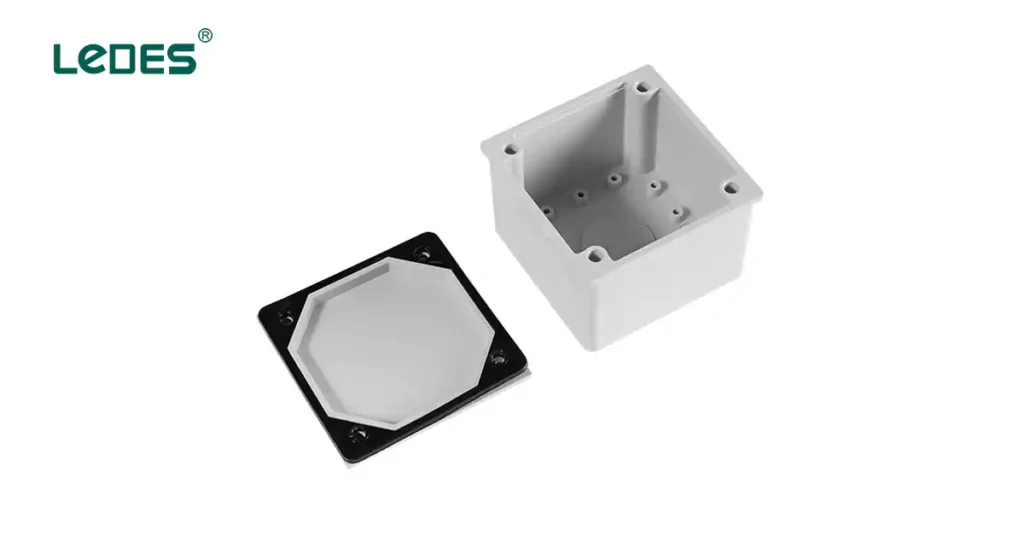
An adaptable box, also known as an anpassbare Anschlussdose or adaptable enclosure, is a type of electrical box designed to accommodate various types of conduits, cables, and wiring connections. These boxes offer flexibility and versatility in terms of the types and sizes of conduits they can accommodate, making them suitable for a wide range of electrical installations.
Adaptable boxes are commonly used in residential, commercial, and industrial electrical applications where multiple conduits or cables need to be connected or where future modifications or additions may be required. They provide a convenient solution for routing and protecting electrical wiring.
Conduit Body (Definition and Purpose)
A conduit body is a connector that links protective raceways, allowing the passage of electrical wires between locations. It comes in various types, each with its unique wire redirection function. It serves as an intermediary point where conduits can be joined, directionally changed, and accessed for maintenance or wire pulling purposes. Conduit bodies play a vital role in ensuring proper conduit management, facilitating wire routing, and maintaining compliance with electrical codes and regulations.
Switch Boxes (Definition and Purpose)
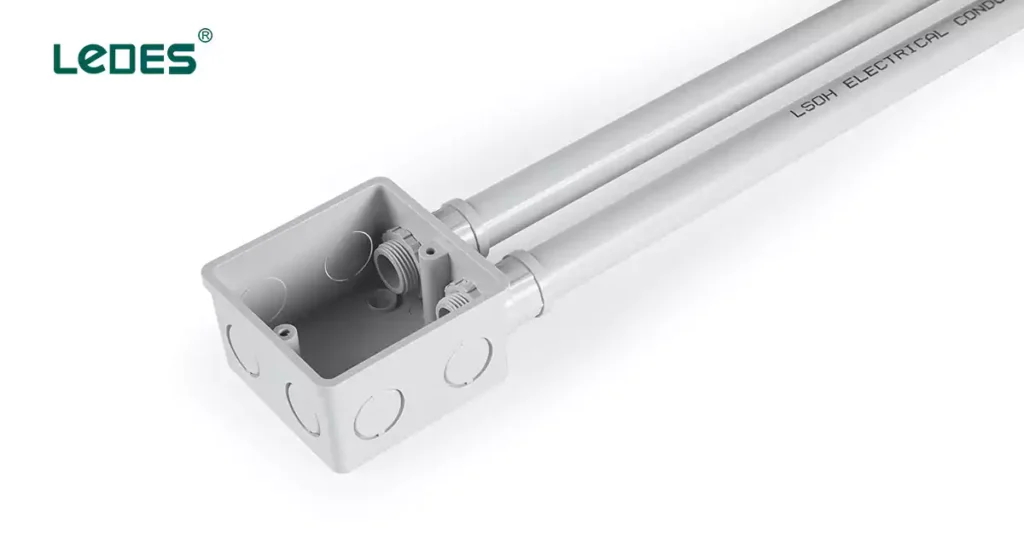
A switch box is a metal or plastic electrical enclosure, installed inside walls, that houses the working parts of a light switch. These boxes provide a safe and organized enclosure for electrical connections associated with switches and outlets.
2 Different Types of Switch Box:
Switch boxes come in various designs to accommodate different installation needs:
Single-gang switch boxes: These boxes are the most common and are used for mounting a single switch or outlet. They provide a compact solution for basic installations.
Multi-gang switch boxes: Used when multiple switches or outlets need to be installed side by side, multi-gang switch boxes have separate compartments for each device. They ensure a neat and organized appearance and simplify wiring management.
Outlet Boxes (Definition and Purpose)
An outlet box is a protective enclosure within an electrical system where wires are housed and connected to devices like switches and appliances. These boxes provide protection to the electrical connections and facilitate easy installation and maintenance of outlets.
2 Different Types of Outlet Box
Single-gang outlet boxes: These boxes are commonly used for mounting a single outlet or receptacle. They offer a compact and efficient solution for basic installations.
Double-gang outlet boxes: Larger in size, double-gang boxes are used when multiple outlets or receptacles need to be installed side by side. They provide separate compartments for each outlet, ensuring a neat and organized appearance.
Gang Boxes (Definition and Purpose)
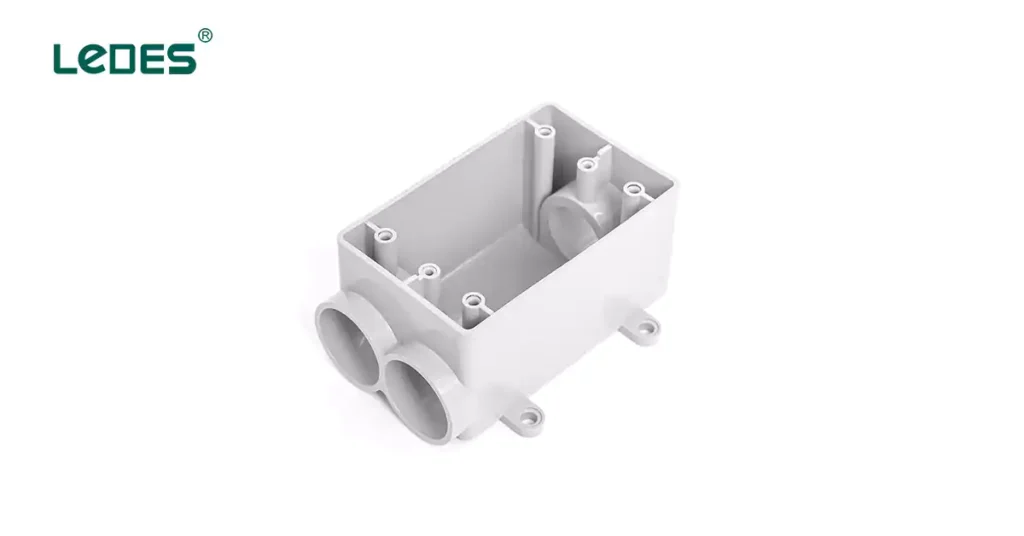
A Verteilerkasten is an electrical enclosure, usually plastic or metal, that mounts to a surface to hold and protect a group of electrical devices like switches and outlets. It provides a safe and organized enclosure for electrical wiring and connections, protecting them from damage and providing a means for easy access for maintenance or modifications.
How to Connect PVC Conduit to an Electrical Box
Connecting PVC conduit to an electrical box requires careful attention to ensure a secure and reliable connection. We list three different ways of connection for rigid conduit and flexible conduit, You can follow these steps to connect PVC conduit to an electrical box:
Vorbereitung
Besorgen Sie sich die notwendigen Werkzeuge und Materialien:
- PVC conduit and appropriate connectors
- Locknuts, bushings, threaded connectors, compression fittings, or push-fit connectors
Screwdriver, wrench, or suitable tools
- Thread compound or tape (if using threaded connections)
Ensure the electrical box is properly installed and grounded:
- Ensure that the electrical box is securely mounted and properly grounded according to the applicable electrical codes and regulations.
- Check that the box is suitable for the intended use and compatible with PVC conduit connections.
Verify size and type:
- Ensure that the PVC conduit diameter matches the knockout holes or connectors on the electrical box.
- Confirm that the electrical box is designed for the specific type of PVC conduit being used (rigid or flexible).
Knockout Connections (10 Steps)
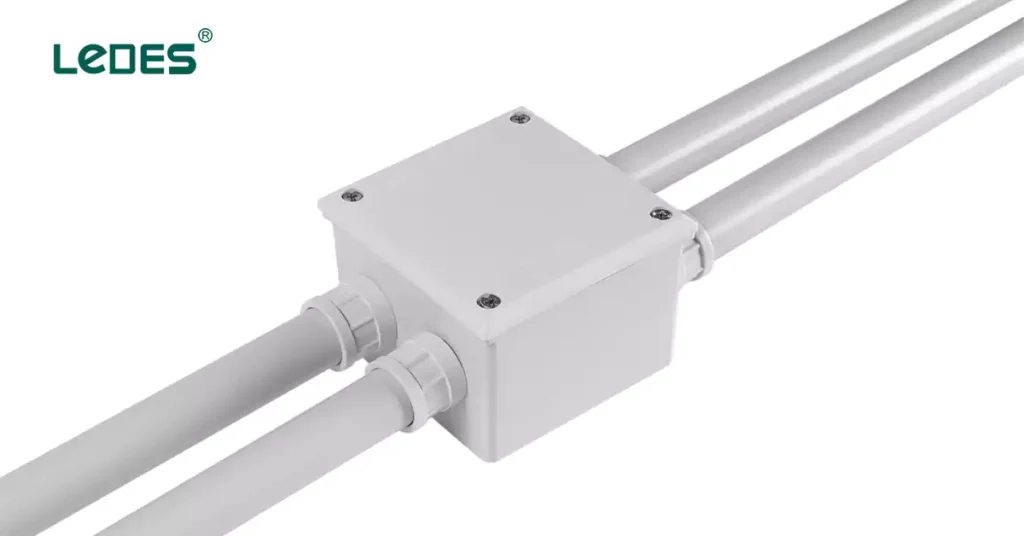
Boxes that commonly designed with knockout holes are usually used with rigid PVC conduit. Such as adaptable boxes and switch boxes. For these boxes, here is a general guideline for connecting them with PVC conduit:
- Gather the necessary materials: You will need PVC conduit, PVC connectors, PVC cement, a hacksaw or PVC cutter, a utility knife, a screwdriver, and a switch box.
- Measure and cut the PVC conduit: Measure the length of conduit needed to connect the switch box to the desired location. Use a hacksaw or PVC cutter to cut the conduit to the appropriate length. Ensure the cut is straight and clean.
- Prepare the conduit ends: Use a utility knife to remove any burrs or rough edges from the cut ends of the conduit. This will ensure a proper fit when connecting the conduit to the switch box.
- Attach the PVC connectors: Slide PVC connectors (such as adapters) onto each end of the conduit. The connectors should fit snugly over the conduit ends.
- Apply PVC cement: Apply PVC cement to the inside of each connector and the outside of the conduit ends. Make sure to follow the instructions on the PVC cement regarding drying time and application.
- Insert the conduit into the switch box: Locate the knockout hole on the switch box that aligns with the conduit. Gently insert one end of the conduit into the knockout hole. Push it in firmly until it is fully seated in the box.
- Secure the conduit: Inside the switch box, use a screwdriver to tighten the screws on the PVC connectors. This will secure the conduit in place and provide a tight seal.
- Repeat for additional conduit connections: If you need to connect multiple conduits to the switch box, repeat steps 2-7 for each conduit.
- Test the connection: Once all the conduit connections are made, double-check that they are secure and properly seated in the switch box. Ensure there are no loose parts or gaps.
- Follow up with wiring: With the conduit securely connected to the switch box, you can proceed with wiring as needed, following electrical codes and regulations.
Direct Connection (9 Steps)
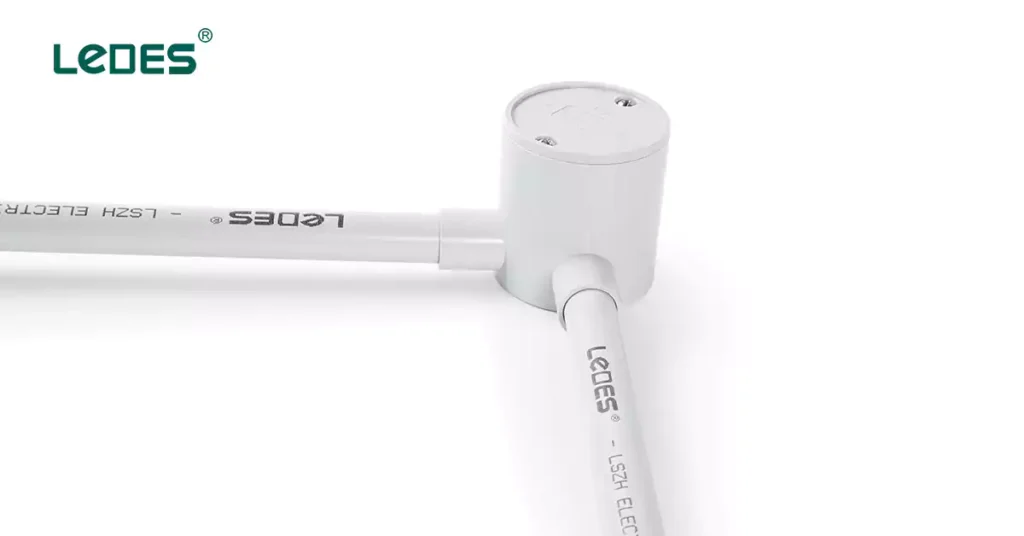
Electrical Boxes such as junction boxes and conduit bodies that designed with hubs on the box, can directly connect with rigid PVC conduit using only PVC solvent cement, here are the steps of the connection.
- Measure and cut the PVC conduit: Measure and cut the PVC conduit to the desired length using a hacksaw or PVC cutter. Ensure that the conduit is cut squarely to create a clean and straight end.
- Remove any burrs: Use a utility knife or a deburring tool to remove any burrs or rough edges from the cut end of the conduit. This will help ensure a proper fit and a secure connection.
- Clean the conduit and box: Wipe the exterior of the conduit and the interior of the electrical box (such as junction box and conduit body), using a clean cloth to remove any dirt, dust, or debris. This will help ensure a clean surface for the PVC cement to bond effectively.
- Apply PVC primer (if required): Some PVC cement manufacturers recommend applying a PVC primer to both the conduit and the box before applying the cement. The primer helps clean and prepare the surfaces for better adhesion. Check the manufacturer’s instructions to determine if primer application is necessary.
- Apply PVC cement: Apply a generous amount of PVC cement to the exterior of the conduit end, covering approximately 2 to 3 inches of the conduit’s length. Also, apply PVC cement to the interior of the hub opening on the box.
- Insert the conduit into the box: Firmly insert the conduit into the hub opening of the box, ensuring a tight and secure fit. Rotate the conduit slightly to evenly distribute the cement and create a strong bond between the conduit and the body.
- Hold in place: Hold the conduit in place for a few seconds to allow the PVC cement to set and create a strong connection. Follow the manufacturer’s recommended curing time for the PVC cement.
- Repeat for additional conduit connections: If connecting multiple conduits to the same conduit body, repeat steps 1 to 7 for each conduit.
- Allow for proper curing: After completing the connections, allow sufficient time for the PVC cement to fully cure according to the manufacturer’s recommendations before subjecting the installation to stress or pulling on the conduits.
Push-Fit Connections (7 Steps)
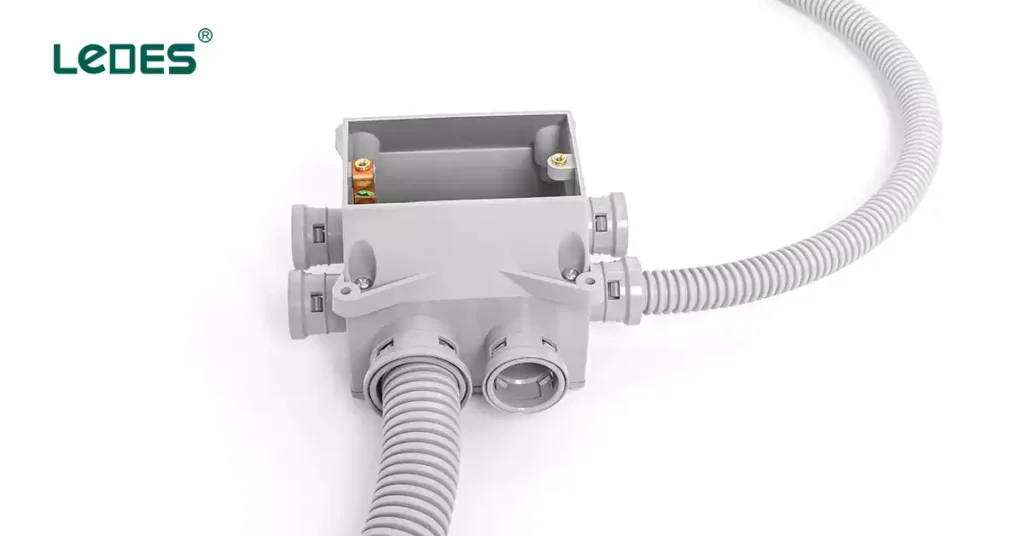
For these electrical boxes that designed with tabs, such as gang boxes, ceiling boxes, are normally connecting with flexible and corrugated conduit, these boxes’ connection require no additional tools or connectors. Here is a general guideline for connecting them to PVC flexible conduits and tubes.
- Prepare the corrugated conduit: Measure and cut the corrugated conduit to the desired length using a hacksaw or conduit cutter. Ensure that the conduit is cut squarely to create a clean and straight end.
- Inspect the electrical box: Check the box ( such as gang boxes and ceilings) for any damage or defects. Ensure that the tabs or connectors on the box are intact and in good condition for a proper connection.
- Align the conduit with the box: Hold the cut end of the corrugated conduit against the tabs or connectors on the box. Ensure that the conduit is aligned properly to fit securely onto the box.
- Push the conduit onto the box: Apply firm and even pressure to push the conduit onto the tabs or connectors of the box. It should slide or snap into place, creating a secure connection.
- Check the connection: Inspect the connection to ensure that the conduit is securely attached to the box. Verify that the tabs or connectors have engaged with the corrugations of the conduit, providing a tight and reliable connection.
- Repeat for additional conduit connections: If connecting multiple conduits to the same box, repeat steps 1 to 5 for each conduit.
- Ensure proper alignment and seating: Confirm that all the conduits are properly aligned and seated on the tabs or connectors of the box. This will help ensure a secure and reliable connection for the entire installation.
By following these steps, you can successfully connect PVC conduit to an electrical box, ensuring a safe and reliable electrical installation. It’s important to follow electrical codes and regulations and consult the manufacturer’s instructions for the specific conduit box and corrugated conduit you are using. If you are unsure or inexperienced with electrical work, it is recommended to seek assistance from a qualified electrician.
When to Use Plastic Vs. Metal Electrical Boxes
Plastic and metal electrical boxes each have their appropriate applications. Romex wire and plastic junction boxes are commonly paired, particularly for indoor receptacles, although metal enclosures may also be suitable depending on the project. Using metal conduit with plastic boxes is generally unsafe and against electrical codes.
While PVC can melt when overheated, it does not conduct electricity like metal. Use plastic boxes when non-metallic cables lead in or out of the box, as metal-sheathed wiring requires bonding with a metal electric box for grounding and should not be used in plastic boxes.
Let’s explore the scenarios where plastic or metal electrical boxes are commonly used and discuss their pros and cons.
Plastic Electrical Boxes:
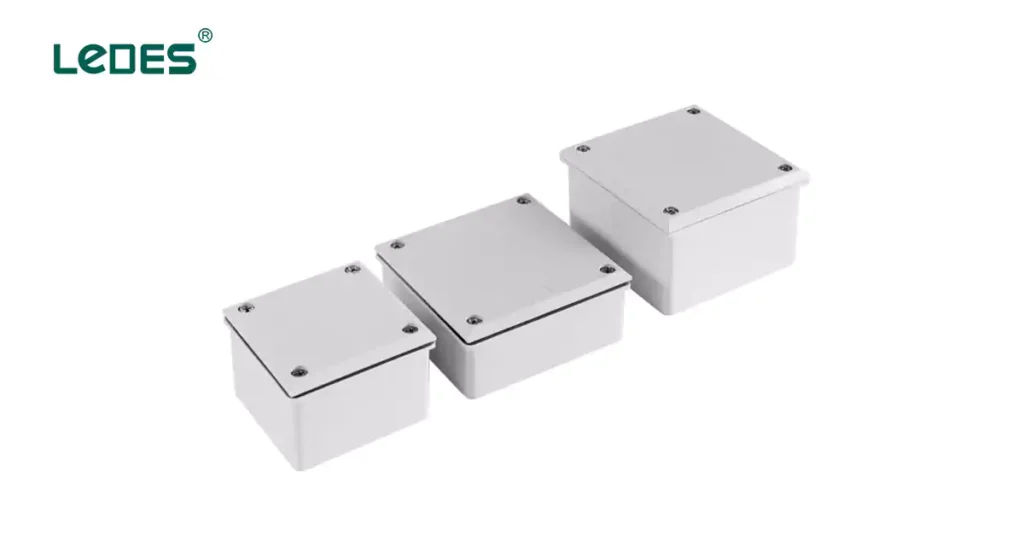
Plastic electrical boxes, typically made of PVC or polycarbonate, offer several benefits that make them suitable for various installations
Vorteile:
Nicht leitend: Plastic boxes are non-conductive, which means they don’t conduct electricity. This property makes them ideal for situations where conductivity needs to be minimized, such as in damp or corrosive environments.
Einfache Installation: Plastic boxes are lightweight and easy to work with. They can be quickly installed using nails, screws, or adhesive. Their flexibility allows for straightforward adjustments and modifications.
Kosteneffizient: Plastic boxes are generally less expensive than their metal counterparts. This affordability makes them a popular choice for residential applications and projects with budget constraints.
Korrosionsbeständigkeit: Plastic is resistant to corrosion, making plastic electrical boxes suitable for outdoor installations or areas exposed to moisture.
Nachteile:
Limited Strength: Kunststoffboxen sind möglicherweise nicht so robust wie Metallboxen, was ihre Eignung für Anwendungen mit hoher Beanspruchung oder Standorte, an denen sie physischen Stößen ausgesetzt sind, beeinträchtigen kann.
Eingeschränkte Hitzebeständigkeit: Kunststoff hält hohen Temperaturen möglicherweise nicht so gut stand wie Metall. Daher werden Kunststoffboxen im Allgemeinen nicht für Installationen empfohlen, bei denen Geräte mit hoher Wattzahl oder Wärmeerzeugung zum Einsatz kommen.
Metall-Schaltkästen:
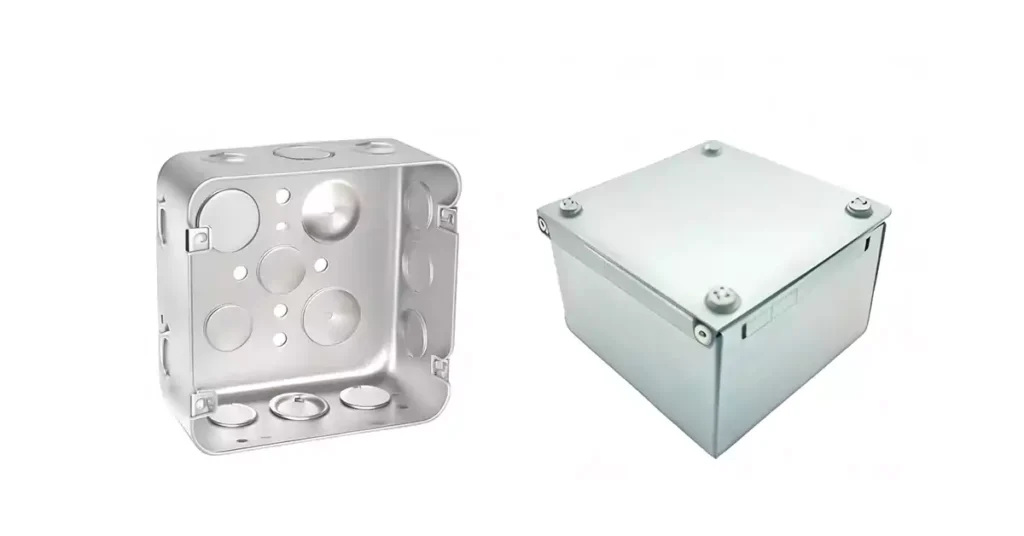
Metallische Schaltkästen, die üblicherweise aus Stahl oder Aluminium bestehen, bieten deutliche Vorteile, die sie für bestimmte Anwendungen geeignet machen:
Vorteile:
Haltbarkeit und Stärke: Metalldosen sind äußerst langlebig und bieten hervorragenden Schutz für elektrische Verbindungen. Sie sind weniger anfällig für Schäden durch Stöße und eignen sich daher für industrielle oder gewerbliche Umgebungen.
Hitzebeständigkeit: Metallboxen vertragen höhere Temperaturen besser als Kunststoffboxen und eignen sich daher für Anwendungen mit wärmeerzeugenden Geräten oder Schaltkreisen mit hoher Wattzahl.
Erdungsfähigkeit: Metallgehäuse bieten aufgrund ihrer Leitfähigkeit eine integrierte Erdung. Dies macht sie für die Erdungsanforderungen in bestimmten Installationen erforderlich.
Nachteile:
Leitfähigkeit: Metallboxen leiten Strom, was bei fehlender Erdung ein Sicherheitsrisiko darstellen kann. Um Stromschläge zu vermeiden, muss darauf geachtet werden, dass die Box richtig geerdet ist.
Korrosionspotential: Wenn Metallboxen Feuchtigkeit oder korrosiven Elementen ausgesetzt sind, können sie mit der Zeit rosten oder korrodieren. Für den Außenbereich oder feuchte Umgebungen sollten geeignete Schutzmaßnahmen in Betracht gezogen werden, z. B. die Verwendung korrosionsbeständiger Beschichtungen oder Edelstahlboxen.
Kosten: Aufgrund des verwendeten Materials und der Herstellungsverfahren sind Metallboxen im Allgemeinen teurer als Kunststoffboxen.
Häufig verwendete Szenarien für Kunststoff- und Metallboxen
Zusammenfassend sind hier einige gängige Szenarien aufgeführt, in denen typischerweise Schaltkästen aus Kunststoff oder Metall verwendet werden:
Plastic Electrical Boxes: Anwendungen im Wohnbereich, trockene Innenräume, kostensensible Projekte, Anforderungen an die Nichtleitfähigkeit und Installationen, bei denen Korrosionsbeständigkeit unabdingbar ist.
Metall-Schaltkästen: Gewerbliche oder industrielle Anwendungen, Außeninstallationen, Umgebungen mit hohen Temperaturen, Erdungsanforderungen und Standorte, die eine erhöhte Haltbarkeit und Stoßfestigkeit erfordern.
Berücksichtigen Sie bei der Wahl zwischen Kunststoff- und Metallverteilerdosen die spezifischen Installationsanforderungen, das Budget, die Umgebungsbedingungen und die elektrische Belastung. Halten Sie sich immer an die örtlichen Elektrovorschriften und -bestimmungen, um eine sichere und konforme Installation zu gewährleisten.
11 Tipps zur sicheren Installation eines Schaltkastens
Bei der Arbeit mit elektrischen Systemen sollte die Sicherheit oberste Priorität haben. Elektrische Installationen sind mit Risiken verbunden und die erforderlichen Vorsichtsmaßnahmen sind für das Wohlbefinden des Installateurs und der Bewohner des Gebäudes von entscheidender Bedeutung. Hier sind einige wichtige Sicherheitsaspekte, die Sie beachten sollten:
4 Tips for Wear & Equipment
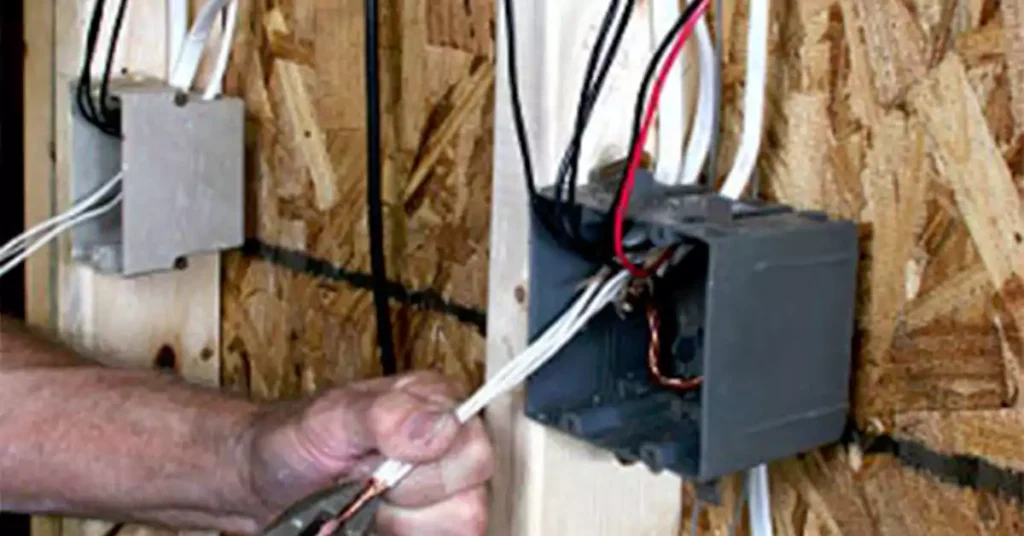
Das Arbeiten mit Elektrizität birgt Gefahren wie Stromschlag, Verbrennungen und Brandgefahr. Es ist wichtig, sich dieser Risiken bewusst zu sein und während des gesamten Installationsvorgangs entsprechende Sicherheitsvorkehrungen zu treffen. Einige wichtige Sicherheitsmaßnahmen, die Sie befolgen sollten, sind:
- Tragen Sie persönliche Schutzausrüstung (PSA): Tragen Sie zum Schutz vor elektrischen Gefahren immer geeignete PSA, z. B. isolierte Handschuhe, Schutzbrille und Schutzkleidung.
- Stellen Sie sicher, dass die Arbeiten kompetent ausgeführt werden: Elektroarbeiten sollten von Personen durchgeführt werden, die über Kenntnisse, Schulungen und Erfahrung in Elektroinstallationen verfügen. Wenn Sie sich bei einem Aspekt der Arbeiten nicht sicher sind, wenden Sie sich an einen qualifizierten Elektriker.
- Sorgen Sie für eine sichere Arbeitsumgebung: Halten Sie den Arbeitsbereich sauber, ordentlich und frei von potenziellen Gefahren. Vermeiden Sie das Arbeiten in der Nähe von Wasserquellen oder bei Nässe.
- Verwenden Sie geeignete Werkzeuge und Geräte: Verwenden Sie isolierte Werkzeuge, die speziell für Elektroarbeiten entwickelt wurden. Überprüfen Sie die Werkzeuge regelmäßig auf Schäden und ersetzen Sie sie bei Bedarf.
3 Tipps zur Stromversorgung
Bevor Sie Verbindungen zu Schaltkästen herstellen, müssen Sie unbedingt die Stromversorgung des Stromkreises oder des Bereichs, in dem die Arbeiten durchgeführt werden, abschalten. Diese Vorsichtsmaßnahme ist unerlässlich, um Stromschläge und Verletzungen zu vermeiden. Befolgen Sie diese Schritte, wenn Sie die Stromversorgung abschalten:
- Identifizieren Sie den richtigen Schutzschalter oder die richtige Sicherung, die die Stromversorgung des jeweiligen Bereichs steuert, in dem die Arbeit durchgeführt wird.
- Schalten Sie den Schutzschalter aus oder entfernen Sie die Sicherung und stellen Sie sicher, dass die Stromzufuhr vollständig unterbrochen ist.
- Überprüfen Sie mit einem Spannungsprüfer, dass im Stromkreis bzw. in den Leitungen keine elektrische Spannung anliegt, bevor Sie mit der Arbeit beginnen.
4 Tipps zur Einhaltung elektrischer Vorschriften
Um die Sicherheit und Konformität elektrischer Anlagen zu gewährleisten, ist es wichtig, die örtlichen Elektrovorschriften und -bestimmungen einzuhalten. Diese Vorschriften enthalten Richtlinien für die ordnungsgemäße Installation, Erdung und andere Sicherheitsmaßnahmen. Hier sind einige wichtige Punkte, die Sie beachten sollten:
- Machen Sie sich mit den geltenden Elektrovorschriften und -bestimmungen in Ihrer Region vertraut. Diese Vorschriften können je nach Rechtsraum unterschiedlich sein.
- Halten Sie sich an die Richtlinien für die Auswahl und Installation von Schaltkästen, Leitungen, Anschlüssen und anderen Komponenten.
- Stellen Sie sicher, dass die Schaltkästen gemäß den Anforderungen der Elektrovorschriften ordnungsgemäß geerdet sind. Eine unsachgemäße Erdung kann zu elektrischen Gefahren und Geräteschäden führen.
- Überprüfen und warten Sie elektrische Anlagen regelmäßig, um sicherzustellen, dass sie weiterhin den neuesten Vorschriften und Bestimmungen entsprechen.
Abschluss
Zusammenfassend lässt sich sagen, dass Schaltkästen überall zu finden sind und für elektrische Installationen unverzichtbar sind. Es gibt viele verschiedene Arten von Schaltkästen, und jeder Typ kann unterschiedliche Installationsanforderungen haben. Daher ist die ordnungsgemäße Installation von Schaltkästen für die Sicherheit und Funktionalität elektrischer Systeme von entscheidender Bedeutung. Unabhängig davon, ob Sie Schaltkästen aus Kunststoff oder Metall verwenden, ist es wichtig, ihre Vorteile, Einschränkungen und geeigneten Anwendungen zu verstehen. Indem Sie die empfohlenen Richtlinien und Sicherheitsvorkehrungen befolgen und auch Ihre örtlichen Vorschriften einhalten, können Sie eine erfolgreiche Installation sicherstellen und das Risiko elektrischer Gefahren minimieren.
Haben Sie Fragen zu elektrischen Systemlösungen, kontaktieren Sie uns bitte jederzeit.



